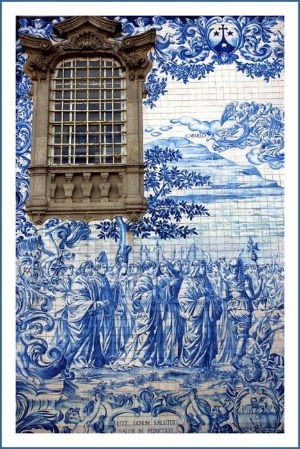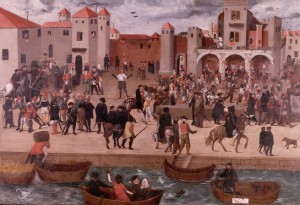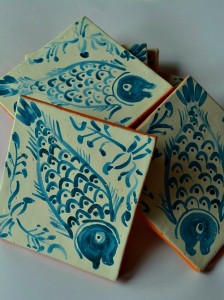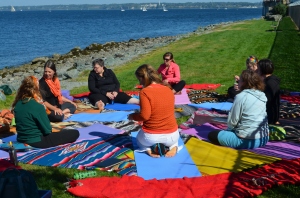I’m delighted to have been introduced to The Next Big Thing — an author blog hop — by the passionate writer and book reviewer Darlene Elizabeth Williams whose blog reviews the latest historical fiction. Visit her site to read engaging book reviews and learn about her books…
Before moving on, I would like to talk briefly about these words “The Next Big Thing” as initially I have issues with giving power to them. For what is “big” to one person is “insignificant” to another. What matters is to follow our calling, to express, to share, to explore — to write.
With this said...a few words by author Marianne Williamson:
(label, substitute, and call “God” what you want– for me it is the ‘Infinite Energy of the Universe’)
“Our deepest fear is not that we are inadequate. Our deepest fear is that we are powerful beyond measure. It is our light, not our darkness that most frightens us. We ask ourselves, Who am I to be brilliant, gorgeous, talented, fabulous? Actually, who are you not to be? You are a child of God. Your playing small does not serve the world. There is nothing enlightened about shrinking so that other people won’t feel insecure around you. We are all meant to shine, as children do. We were born to make manifest the glory of God that is within us. It’s not just in some of us; it’s in everyone. And as we let our own light shine, we unconsciously give other people permission to do the same. As we are liberated from our own fear, our presence automatically liberates others.” – A Return To Love: Reflection on the Principles of a Course in Miracles
I have been asked the following questions:
 1. What is the working title of your book?
1. What is the working title of your book?
CUT FROM THE EARTH
2. Where did the idea come from for the book?
The idea came on a solo painting trip I took to the Peruvian Amazon in 2006. To read the whole story click here! The Story Behind the Story
3. What genre does your book fall under?
Historical Adventure/Thriller w/Magical Realism
4.What actors would you choose to play the part of your characters in a movie rendition?
Johnny Depp, George Clooney or Antonio Banderas as Piloto; Robin Tunney or Penelope Cruz as Paulina; Will Smith as Babau; I am still mulling over who would play Makiki…?
*It would be ideal to cast Portuguese and Brazilian actors for the parts but I don’t know which ones! So, I’ve stayed with names I am familiar with for now.
5. What is the one-sentence synopsis of your book?
CUT FROM THE EARTH is a story of mid-eighteenth century Portuguese tile and of love — defying gender and class — The Great Lisbon Earthquake — and the wisdom of nature and the power of love to guide and heal.
* For more information visit my blog’s Historical Novel page and read the excerpt.
6. Will your book be self-published or represented by an agency?
Currently, my plan is for the book to be represented by an agency.
7. How long did it take you to write the first draft of the manuscript?
I wrote the first draft in roughly 6 months in 2010. But this is after spending 4 years learning Portuguese to do the research. During this time and throughout the writing/rewriting process, I read and researched the history of the time period and traveled to many of the places where the book voyages.
8.What other books would you compare this story to within your genre?
CUT FROM THE EARTH has similarities in storyline and subject matter with historical thriller/adventure novel Pompeii by Robert Harris, while blending with the artist based historical novel, Claude & Camille by Stephanie Cowell. Also, think of the dramatic and atmospheric film The Mission.
9. Who or what inspired you to write this book?
CUT FROM THE EARTH is inspired by my love of Portuguese tile, the beautiful hardwoods of the Amazon, and to explore why one finds azulejos in the Amazon and Amazonian hardwoods in the churches and estates of Europe. In addition, the story is inspirited by my desire to shine light on the often unheard voices and the contributions of minorities and females in the history of the arts.
10. What else about the book might pique the reader’s interest?
I think readers will be interested to learn about the real life event: The Great Lisbon Earthquake that struck Lisbon, Portugal on November 1st, 1755 , All Saints Day. When the vast majority of the city’s population was at church. The incident was followed by tsunami waves and mass fire. These disasters affected the whole of Europe in the eighteenth-century. Today, these historical events and what they triggered are little known, but the history is important and fascinating.

Readers will gain insight about the Mocambo: the predominately black neighborhood on the outskirts of Lisbon — uniquely in existence in a European capital since the sixteenth-century.
![!B9vCzIwCWk~$(KGrHqUOKkEEzLrCmYbpBM6qVZ(S9g~~0_35[1]](http://www.stephaniereneedossantos.com/wp-content/uploads/2013/01/B9vCzIwCWkKGrHqUOKkEEzLrCmYbpBM6qVZS9g0_351.jpg)
Figura de Convite, An Invitation Figure
And, art lovers will be curious to learn about the eighteenth-century Portuguese contribution to the art of tile making — the innovation of the
figura de convite — a life-sized invitation figure that was placed at the head of stair landings and patios to welcome visitors. What is special about this invention is that it is the first time in the history of tile making that the tile composition deviated from the square tile and embraced the outline of the cut-out figure, which opened up a plethora of new design possibilities. Had this not been developed, we may never have had the cardboard movie theater life-sized cut-out of Marilyn Monroe…who knows?
It’s my pleasure to tag the following three talented writers from varying genres in the order they will be posting on their blogs…to carry this blog hop forward:
T.C Paulson will post on January 12th 2013 – http://succumbing.wordpress.com/ – A technical writer by day, a confessionalist poet and novelist by night — she explores imagination, spirit, and the anthropology of existence. Tsena writes about what she knows: pain, pleasure, suffering, peace, victory, loss, joy, demons, angels, daughters, mothers, lovers, and friends. She shares her poetry at open mics around the Pacific Northwest of Washington State, USA. Soak up her works at (you won’t be disappointed!) : http://succumbing.wordpress.com/. Her current novels-in-progress are too secret to reveal at this time…
Andrew Shattuck McBride will post on January 13th 2013 – http://andrewsmcbride.wordpress.com/ – Washington State-based writer and editor, Andrew has poems published or forthcoming in anthologies and journals including Platte Valley Review, Magnapoets, Caesura, Haibun Today, and Clover, A Literary Rag. He has edited four poetry collections and a historical novel. Currently, he is working on a chapbook titled: Reclaiming Air: Poems; a collection of linked short stories; and a new project of lyric essays. To delight your senses and to enjoy word play visit Andrew’s blog: www.andrewsmcbride.wordpress.com or editor’s blog: http://yourwritingcoach.wordpress.com/ .
Christian De Benedetti will post on January 27th, 2013 – http://christiandebenedetti.wordpress.com/ . A freelance writer whose hop charged words have enriched the pages of The New York Times, Esquire, Outside, National Geographic Adventure, GQ, Weekly Pint, and Eaters. He is also author of the award-winning book: The Great American Ale Trail: The Craft Beer Lover’s Guide to the Best Watering Holes in the Nation, THE GREAT AMERICAN ALE TRAIL: The Craft Beer Lover’s Guide to the Best Watering Holes in the Nation . Christian is a very busy writer. Also, he is one of the masterminds behind, “The Bräuler” a stainless steel growler– used to transport or store your favorite brewed beer, for more information see: http://thezythosproject.com/.

![hns-twitter[1]](http://www.stephaniereneedossantos.com/wp-content/uploads/2013/01/hns-twitter1.jpg)


![!B9vCzIwCWk~$(KGrHqUOKkEEzLrCmYbpBM6qVZ(S9g~~0_35[1]](http://www.stephaniereneedossantos.com/wp-content/uploads/2013/01/B9vCzIwCWkKGrHqUOKkEEzLrCmYbpBM6qVZS9g0_351.jpg)


